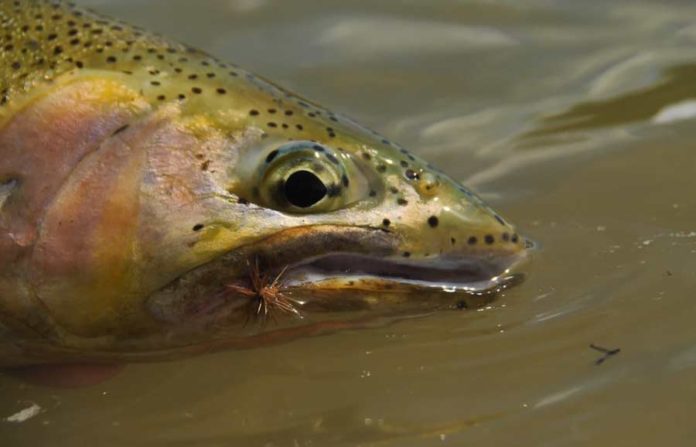Fall dry-fly fishing can be very productive.
Photo by Dave Jensen
The shorter days and crisper nights of fall turn the thoughts of many fly fishers to hunting trophy trout with streamers, but that doesn’t mean you should put away the 4-weight rod, floating line, and dry-fly box. The hatches of autumn—although they may not compare to the blizzard emergences of spring and early summer—continue to draw fish to the surface to feed and can provide fast action. Instead of blowing out your rotator cuff chucking conehead monstrosities on sinking-tip lines all day, you can enjoy the pinnacle of the sport: dropping a tiny dry in front a feeding trout and watching it eat.
One of the best parts of fall dry-fly fishing is that the streams are considerably less crowded, with many anglers having put up their tackle in favor of the shotgun or bow. That means your favorite pools, where you usually have to arrive at the crack of dawn to ensure your spot, will be relatively empty. Plus, as temperatures cool, the fish feed later and later in the day, allowing you to sleep in. In early fall, dawn to noon continues to be the best time to find dry-fly action, but once you need to start wearing a fleece under your waders, most hatches will occur from noon to late afternoon.
Rivers are usually lower in the fall than they are in spring and summer, which has its advantages and disadvantages. There are fewer lies available to trout, which means you can find them easier, but the fish are also more wary. Fall trout will quit feeding more quickly than those driven mad by a blanket hatch, so anglers must employ stealth tactics, wading carefully and using longer, lighter leaders.
Here are four of the best fall dry-fly opportunities around the country.

The Sparkle Dun is a great fall BWO pattern.
Photo via orvis.com
Blue-Winged Olives: From the Northeast to the Rockies, the most abundant fall hatches are those of Baetis—blue-winged olives or BWOs—and from September through November, you should never be on the water without a box of these patterns. Although this is the most productive hatch of the season, it’s also one of the more challenging because of the size of the insects. Whereas for spring BWO hatches, you can use a size 16 fly, in fall you’ll rarely see them larger than an 18 and might have to go as small as size 22. Luckily, these tiniest patterns usually hatch in flat water, but if you find you can’t see the fly, tie it as a dropper behind a more visible dry.
BWOs usually hatch in mid-morning, on cloudy days or even during an early snowstorm. Look for rising fish first in slower currents along the banks, as well as in side channels and eddies. As the hatch progresses, trout will feed in pools and tailouts. A stealthy approach, accurate casting, and a drag-free drift are the keys to success.
Isonychia Mayflies: Because they have been seeing Isonychia mayflies for months by the time fall rolls around, trout are accustomed to seeing these flies as tasty morsels. Also known as mahogany duns, these insects start hatching in late spring in the East and Midwest and continue right through fall. Unlike BWOs, Isonychia are sporadic hatches, which means you won’t fund thousands of insects on the water at one time. Instead, they are like a regular snack for the fish. Guide Joe Demalderis, who fishes New York’s Delaware system even uses an Isonychia dun as a searching pattern to draw fish out of riffles in fall.
In Montana, the mahogany duns emerge in earnest starting in September and really get going in mid-October, usually between 1:00 and 4:00 in the afternoon. Guide John Herzer says to look for them in slow, wide water and eddies, where fish will establish narrow feeding lanes that call for accurate casts.

Derek Young’s Yak Caddis is an October staple on the Yakima.
Photo via orvis.com
Dicosmoecus Caddisflies: Anglers in the Pacific are lucky to have some bigger bugs to throw in fall, including Dicosmeocus—also known as the giant orange sedge or October caddis. The smallest of these calls for a size 10 fly, but you may even find them up to size 6. Dicosmeocus usually hatch on windy days and then fly to streamside vegetation. Derek Young, who guides on the Yakima in Washington, fishes dry flies along the bank near overhanging trees and bushes. Once the females start laying eggs, however, you don’t want a dead drift. Instead, skating or twitching you fly can draw savage strikes.

The Psycho Ant is a killer fall terrestrial pattern.
Photo via orvis.com
Terrestrials: Summer lasts longer in the south, so terrestrial fishing usually lasts well into November or until the first hard frost, and a beetle or ant will be your best prospecting option. Dave Hise, who guides in western North Carolina, says you can’t go wrong with a Chernobyl-style hopper pattern with a sunken ant as a dropper. Fished among the fallen leaves on the water, this combo will bring fish up through several feet of water.
For fishing the big tailwaters of the mid-South, Arkansas guide Jamie Rouse suggests terrestrials tied with foam bodies and fished right along the bank. His favorite pattern is the Psycho Ant. But really, you need a good selection of hoppers, cicadas, ants, and beetles. Watch for days when the dams are generating and the water is up, which washes terrestrials off the banks, and don’t be afraid to fish in bright sun.
Ultimately, fall offers the best of both worlds—great streamer action and productive hatches. So bring two rods to the river, one to chuck meat and the other to drift surface patterns, and you just might catch your best fish of the season.
Credit: Source link































